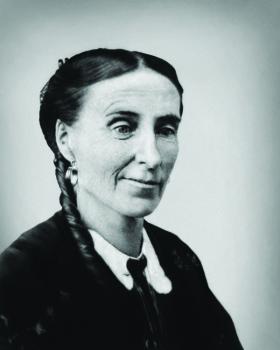‘Blind poetess of Ulster’: photo recently discovered
Published in 18th–19th - Century History, Issue 3 (May/June 2010), News, Volume 18
The only known photograph of the ‘blind poetess of Ulster’, Frances Browne, rediscovered in Australia in October 2009. (Selwyn Glynn)
Frances Browne was born in Stranorlar, Co. Donegal, in 1816. By the time of her death in 1879 she had carved out a relatively successful literary career as a prolific poet, essayist, novelist and writer of children’s stories that had taken her from her quiet village to the bustling cities of Edinburgh and London—despite having been struck completely blind by smallpox at the tender age of eighteen months and having received no regular education. She educated herself by listening to her siblings reciting their school lessons, by memorising what she heard and by assiduously questioning adults in her desire to learn.
Her earliest interest was in fiction, especially the writings of Sir Walter Scott. By her teenage years, however, she had become more interested in what she termed ‘the far more wonderful romance of history’. Her poetry and stories contain many allusions to historical events—the French Revolution is very prominent, and her interest in history was first stimulated by Baine’s History of the French Wars. Her best-known poem, ‘Songs of our Land’, celebrating the role of bards in preserving the spirit of the Irish nation, has often appeared in anthologies of patriotic verse.
Browne made c. 100 contributions to the popular Scottish magazine Chambers’s Journal between 1845 and 1870. She also contributed many poems to the prestigious London literary periodical The Athenaeum from as early as 1841, when she was still living in the isolated outpost of Stranorlar. After moving to London in 1852, much of her writing was carried out for the evangelical Religious Tract Society. In 1863 Frances was honoured with a £100 p.a. pension from the civil list. The major disappointment in her career came in 1867, when, owing to ill health and non-payment by some publishers, she was forced to declare bankruptcy. Despite this humiliating setback, she continued writing right up to her death (of apoplexy) in August 1879. She died unmarried and in her will left less than £100 and all her belongings to Eliza Hickmann, her faithful servant and companion during the last sixteen years of her life. She was buried in the now-overgrown public cemetery in Richmond-upon-Thames; the number of her burial plot is known but no graveyard map has as yet been found to enable us to identify the exact location.
In recent times there has been a growing academic interest in her career. There is, for example, an excellent summary of her life in the Oxford Dictionary of National Biography. (Unfortunately, the brief entry in the recently published Dictionary of Irish Biography contains a number of factual inaccuracies, but the editors have assured me that these will be rectified in due course in the on-line version.) She is attracting increasing attention from those interested in studying Victorian women writers. In the Dictionary of Literary Biography, Marya DeVoto has provided a very sophisticated analysis of her literary output. In addition, given her birth in east Donegal to a Presbyterian family (her father, Samuel, was the local postmaster), her story is of interest to those studying Ulster-Scots heritage. She authored more than twelve ‘legends of Ulster’, which are rich in the lore of the countryside. Frances Browne is still best remembered for her richly imaginative fantasy book for children, Granny’s wonderful chair and its tales of fairy times. Since its first publication in 1856 it has been reprinted many times and has been translated into many languages; it was an international bestseller in the late nineteenth century.
In spite of this renewal of interest, however, no portrait or photograph of the poetess could be traced. Searches were conducted in local newspapers, in the National Library of Scotland, in the British Library and in many other places but nothing turned up. Then, in the late summer of 2009, a distant relative (descended from one of her brothers, Revd John Browne) from Brisbane, Australia, came on a visit to Stranorlar in search of her roots. She had the good luck to go into the local post office, where she met Browne’s biographer, postmaster Patrick Bonar. Having learnt so much about her accomplished relative, the lady returned to Australia and began to search through the heirlooms of her wider family circle. Wonderfully, in October 2009, in her aunt’s house, she came across the photograph of the poetess reproduced here. This marvellous discovery will further help to restore the fame of this remarkable woman, who overcame geographical isolation, gender disadvantage and severe disability to carve out a literary name for herself in Victorian Britain and Ireland. HI
Raymond Blair is a native of Stranorlar, Co. Donegal, and an active member of the County Donegal Historical Society.
















